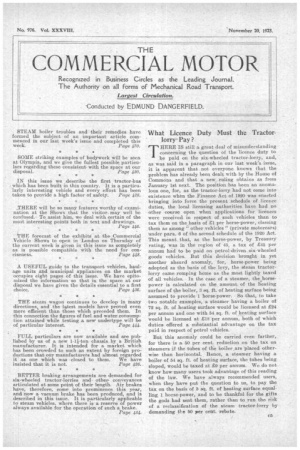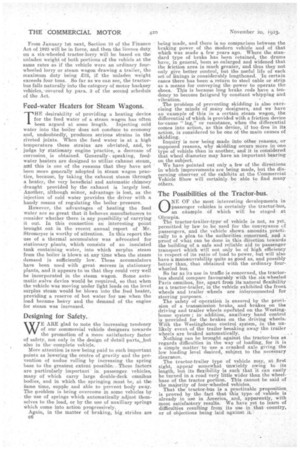What Licence Duty Must the Tractor lorry. Pay ?
Page 1

Page 2

If you've noticed an error in this article please click here to report it so we can fix it.
THERE IS still a great deal of misunderstanding concerning the question of the *licence duty to be paid on the six-wheeled tractor-lorry, and, as was said in a paragraph in our last week's issue, it is apparent that not everyone knows that the problem has already been dealt with by the House of Commons and that a new ruling obtains as from January 1st next. The position has been an anomalous one, for, as the tractor-lorry had not come into existence when the Finance Act of 1920 was enacted bringing into force the present schedule of licence duties, the local licensing authorities have had no other course open when applications for licences were received in respect of such vehicles than to tax them an the basis of 21 per horse-power, classing them as among '-` other vehicles " (private motorcars) under para. 6 of the second schedule of the 1920 Act. This meant, that, as the horse-power, by Treasury rating, was in the region of 45, a tax of 245 per annum had to be paid on petrol-driven six-wheeled goods vehicles. But this decision brought in yet another absurd anomaly, for, horse-power being adopted as the basis of the levy, the steam tractorlorry came romping home as the most lightly taxed of all vehicles. In the ease of a steamer, the horsepower is calculated on the amount of the heating surface of the boiler, 3 sq. ft. of heating surface being assumed to provide 1 horse-power. So that, to take two notable examples, a steamer having a boiler of 72 sq. ft. of heating surface would be licensed at 224 per annum and one with 54 sq. ft.. of heating surface would be licensed at 218 per annum, both of which duties offered a substantial advantage on the tax paid in respect of petrol vehicles.
But this anomaly could be carried even farther, for there is a 50 per cent. reduction on the tax on steamers if the tubes of the boiler are -placed otherwise than horizontal. Hence, a steamer having a boiler of 54 sq. ft. of heating surface, the tubes being sloped, would be taxed at 29 per annum. We do not know how many users took advantage of this reading of the law. We have always recommended users, when they have put the question to us, to pay the tax on the basis of 3 sq. ft. of heating surface equalling 1 horse-power, and to be thankful for the gifts the gods had sent them, rather than to run the risk of a reclassification dl the steam tractor-lorry by demanding the 50 per cent. rebate. From January 1st next, Section 10 of the Finance Act of 1923 will be in force, and then the licence duty on a six-wheeled tractor-lorry will be based on the unladen weight of both portions of the vehicle at the same rates as if the vehicle were an ordinary fourwheeled lorry or steam wagon drawing a trailer, the maximum duty being £32, if the unladen weight exceeds four tons. So far as we can see, the tractorbus falls naturally into the category of motor hackney vehicles, 'covered by para. 3 of the second schedule of the Act.
Feed-water Heaters for Steam Wagons.
THE desirability of providing a heating device for the feed water of a steam wagon has often been argued at some length. Injecting cold water into the boiler does not conduce to economy and, undoubtedly, produces serious strains in the riveted joints. When the feed water is at a high temperature these strains are obviated, and, to ' judge by stationary engine 'practice, a decrease of corrosion, is obtained. Generally speaking, feedwater heaters are designed to utilize exhaust steam, artd this is one of the reasons that they have not ' been more generally adopted in steam wagon practice, because, by taking the exhaust steam through a heater, the very beneficial and automatic chimney draught provided by the exhaust is largely lost. Another, although minor, advantage is lost, as the injection of cold water provides the driver with a handy means of regulating the boiler pressure. However, the advantages of heating the feed water are so great that it behoves manufacturers to consider whether there is any possibility of carrying it out. In this connection an interesting point brought out in the recent annual report of Mr. Stromeyer is worthy of attention. In this report the use of a thermal accumulator was advocated for stationary plants, which consists of an insulated tank containing water, into which surplus ' steam from the boiler is blown at any time when the steam demand is sufficiently low. These accumulators have been used with great success in stationary plants, and it appears to us that they could very well be incorporated in the steam wagon. Some automatic waive device would be required, so that when the vehicle was moving under light loads on the level surplus steam would be blown into the feed heater, providing a reserve of hot water for use when the load became heavy and the demand of the engine for steam was increased.
Designing for Safety. •
WE ARE glad to note the increasing tendency of our commercial vehicle designers towards the promotion of a more satisfactory factor of safety, not only in the design of detail parts,,but also in the complete vehicle. More attention is now being paid to such important points as lewering the centre of gravity and the prevention of undue rolling by increasing the spring base to the greatest extent possible-. _ These factors are particularly important in passenger. vehicles, many of which carry large double-deck omnibus bodies, and in which the springing must be, at the game time, supple and able to prevent body sway. The problem is being overcome in some vehicles by the use of springs which automatically adjust themselves to the load, or by the use of auxiliary springs which come into action progressively. Again, in the matter of braking, big strides are .06 being made, and there is no comparison between the braking power of the modern vehicle and of that which was made a few years ago. Where the standard type of brake has been retained, the drums have, in general, been so enlarged and widened that the friction area is much greater, and thus they not only give better control, but the useful life of each set of linings is considerably lengthened. In certain cases there has been a return to steel cable or strip as a means for conveying the -power to operate the shoes. This is because long brake rods have a tendency to become fatigued by congtant whipping and vibration. The problem of preventing skidding is also exercising the minds of many designers, and we have an example of this in a certaie steam wagon, the differential of which is provided with a friction device to,eause "lag," or resistance, when the differential comes into action, as this device' if too -free in its action, is considered to be one of the main causes of skidding., , Inquiry is now being made into other reasons, or supposed reasons' why skidding occurs more in one type of vehicle than in another, and it is considered that wheel diameter may have an important bearing on the subject. We have pointed out only a few of the directions in which improvements are being made, but the discerning observer of the exhibits at the Commercial Vehicle Show will certainly be able to find many others.
The Possibilities of the Tractor-bus.
ONE OF the most interesting developments in passenger vehicles is certainly the tractor-bus, an elample Of which will be staged at Olympia. The tractor-trailer-type of vehicle is not, as yet, permitted by law to be used for the conveyance of passengers, and the vehicle shown amounts practically to a plea to the authorities concerned, san el a proof of what can be done in this direction towards the building of a safe and reliable aid to passenger transport which will not only be of high efficiency in respect of its ratio of load to power, but will also have a manceuvrability quite as good as, and Possibly better than, that obtained with the ordinary fourwheeled bus. So far as its use in traffic is concerned, the tractorbus should compare favourably with the six-wheeled Paris omnibus, for, apart from its natural flexibility as a tractor-trailer, in the vehicle exhibited the front wheels and trailer wheels are inteeconnected for steering purposes. The safety of operation is ensured by the provision of a transmission brake, and brakes on the driving and trailer wheels opefated on the Westinghouse system ; in, addition, auxiliary hand control is provided for the brakes on the driving wheels. With the Westinghouse control system, in the unlikely event of the trailer breaking away the trailer
wheels are braked automatically. , .
Nothing can be brought against the tractor-bus as regards difficulties in the way of loading, for it is a simple matter to use a cranked axle giving the low loading level desired, subject to the necessary clearance. The tractor-trailer type of vehicle may, , at first sight, appear somewhat unwieldy owing to its length, but its flexibility is such that it can easily be turned in a road very little wider than the wheelbase of the tractor portion. This cannot be said of the majority of four-wheeled vehicles. That the tractor-bus is a practicable proposition, is proved by the fact that this' type of vehicle is already in use in America, and, apparently, with most satisfactory, results. We have yet to learn of difficulties resulting from its use in that country, or of objections being laid against it.
























































